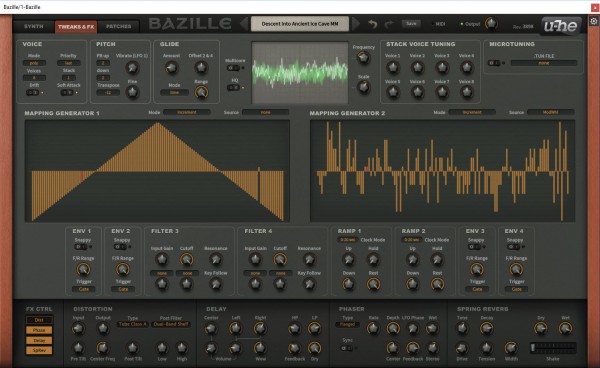The Infectious Charm of the Bazille
Sometimes, a little change of pace can be a welcome thing and provide an opportunity to "think different." In that spirit, we asked our synthesist pal Mark Mosher (whose Sonic Encounters podcast you may find of interest if you're not already acquainted) to aim us at an interesting softsynth plug-in that he finds compelling. Welcome, Mark! -- Gregory
Let me introduce you to the U-He Bazille - a 32/64-bit VST2/AU softsynth plug-in whose ancestry traces back through the Roland 100M and U-He owner Urs Heckmann’s own ACE softsynth. The Bazille (German for “bacterium”) combines a user interface that will be familiar to anyone who’s worked with modular synthesis: a rack of digital oscillators, analog-style filters, and modeled effects with a virtual cable patching system for routing audio and control signals. The default interface is tabbed for easy access to various components (braver users with better eyesight will enjoy the "gearporn” skin that shows everything with a single view).

A brief overview of the modules themselves suggest the possibilities: The oscillators are digital and combine FM and various forms of Phase Distortion synthesis. The resonating filters feature a cascading architecture that allows access to 6 filter types in parallel with all filter types allowing for resonance with self-oscillation. Bazille’s two LFOs run from low to audio rates (frequency or clock-selectable) with three parallel outputs each. Finally, the real time effects include tube and transistor distortion, delay, phasor, and a spring reverb that features a “shake” button that lets you emulate banging on the side of the reverb tank.
These modules are patchable. Working with the virtual patchcords is very straight-ahead - module sockets are color-coded (Grey sockets are inputs, red sockets are outputs), and it’s click-and drag to patch. The patching interfaces features a few nice tweaks, too (double-clicking deletes patchcords, and dragging a cable from an unused input to another that is already in use creates a daisy-chain that patches the source to both inputs, as shown here). The softsynth’s Multiplex module extends the patching metaphor by allowing you to mix/split signals to modules with several cables for simple mixing/attenuation, ring modulation/fade in, amplitude modulation/fade out, and unipolar and bipolar crossfades - with additional modulation sources to scale output.
Bazille includes two modules that really set it apart and should set the Max programmer’s heart to beating: a pair of mapping generators and a morphing modulation sequencer.

The mapping generators let you draw in lists that can hold up to 128 values to be used as processing modulation sources, or as oscillator waveforms. The generators have multiple modes (Key, Map Smooth, Map Quantize, and Increment) that let you control how events are generated.
The morphing modulation sequencer goes way beyond a simple 16-step sequencer; its 4 output "taps" can be sent to any input each at a different speed, and the sequencer also includes 8 pattern snapshots which you can manually morph between. Finally, the sequencer is polyphonic - each played note can trigger its own instance of the sequence. As you might imagine, the morphing modulation sequencer is well suited for West-coast style synthesis, complex drones, and as a source for Max patching ideas in your own work.
I found Bazille to be fun and inspiring and was able to quickly dial-in predictable results as well as be inspired by happy accidents by swapping cables. You can find a Soundcloud example of the Bazille in action (a Bazille patch performing in a single pass with no edits manipulating notes, mod wheel, key pressure, and parameters via midi-mapped knobs) here.
If you've never used a modular before, I recommend you start with Heckmann’s earlier ACE softsynth – if you’re already modular-aware, you should be able to jump right in once they get a handle on the interface.
Bazille holds up well in real time to having its knobs being modulated from Max for Live devices, too – you may even want to create your own Max for Live devices to enable idiosyncratic configurations (for some weird fun, you can MIDI map input sockets modulating the act of plugging in a cable at incredible speeds not capable with human hands (you can find an example of that done on the early ACE softsynth here).
Bazille can be rather demanding on your CPU (although it runs just fine on my beefy Windows machine). You can throttle the synth up using its Multicore (which distributes voices evenly between the CPU cores) and HQ (higher quality) options. In any case, running monophonic presets without voice stacking should work fine even on older machines.
I think you'll find this well worth your time.
by Mark Mosher on May 3, 2016

